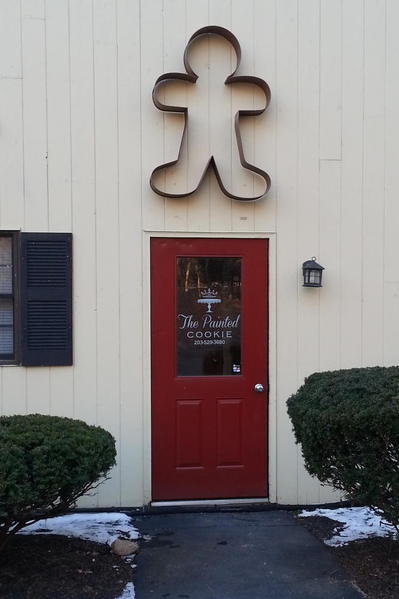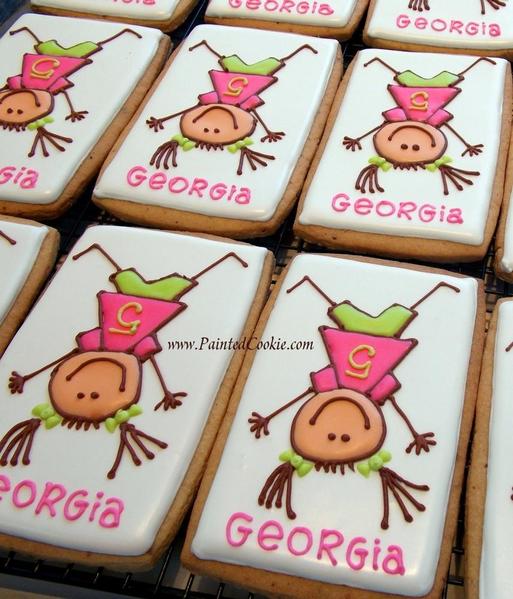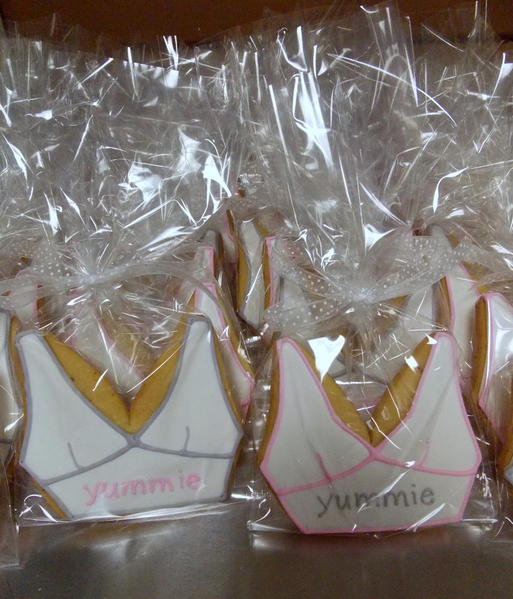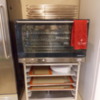This week, our CookieCon 2014 series continues with the talented and oh-so-entrepreneurial Susan Schmitt of The Painted Cookie.
As it turns out, Susan harks from Wilton, Connecticut, not far from my hometown of Guilford - a very cool coincidence! Not quite so cool, however, is the fact that Connecticut is one of those US states without a cottage food law, making it more challenging in many respects to grow a fledgling food business there. But hurdles o’ plenty haven’t fazed Susan much. In January 2013 when confronted with the question of “to expand or not to expand?”, she boldly took the leap from home into a brick-and-mortar bakery.
And did she ever leap gracefully! Today, just one year later, she’s making about 200 to 400 cookies per week and is garnering lots of attention in her community. Just check out this video to see what I mean. (Stay tuned throughout - you won’t want to miss her cookie decorating showdown with the newscaster near the end.)
Yep, Susan is clearly the perfect person to talk to us about building a cookie business, which is precisely what I intend to do (along with peppering her with CookieCon questions, of course)! Ready. Set. Go!
![]()
JMU: Hi, Susan. It’s so nice to have this chance to get to know you. Just curious, did you grow up in Wilton, Connecticut? If so, I was in Connecticut from 1962 until 1984, and, who knows, we might have crossed paths as young cookiers! [Oops, I believe I just aged myself.] ![]()
![]()
SS: Hi, Julia. So nice to chat with you, too! I have lived in many Connecticut towns (Orange, Westport, Wilton, Georgetown, and Ridgefield . . .) from growing up through graduating high school in Ridgefield in 1980. (Oops, and I just aged myself too!) [EDITOR'S NOTE: Another funny coincidence, we are exactly the same age!]
The Painted Cookie retail shop entry.
![]()
JMU: I’m going to try to cover the gamut of “growing a business” questions, from location selection to permitting to pricing and marketing, all in a very short time. Many of our members are grappling with similar “to grow or not to grow” decisions, so you’re joining us at just the right time.
That said, I understand you were making cookies for five or six years prior to opening your shop. What factors led you to finally take the leap into your own place?
![]()
SS: I had a growing client list of steady customers, and large orders of 200-plus cookies were happening more frequently. I had branded myself as a baker of “custom” cookies with a specialty in personalized favors, and the orders kept coming. I had become well known in our community, especially with mothers who wanted a cookie favor in the theme of their child’s party with their name on it. My boys were getting older (they were 13 and 16 when I opened the shop), and my husband kept telling me, “You have a great product; once you are out there, they will come."
Cartwheel Cookies by The Painted Cookie.
![]()
JMU: What considerations went into site selection? For instance, were you seeking a place with great foot traffic, or the lowest cost rental space? Or something else? Did you lease or buy, and why? How should someone weigh these various factors when opening up his/her own shop?
![]()
SS: My biggest challenge was finding a space that I could afford in Wilton. The cost ranged from $24 to $45 per square foot. So I had to locate a space under 1,000 square feet, which proved to be quite challenging until I found a space the landlord was willing to split in half, giving me about 650 square feet. I signed a three-year lease, and we started working on the space to transform it into a kitchen. I am fortunate that my husband is a contractor who could look at the space and easily say, “Yes, we can get water access into here”, or whatever else I might need. Our shop is off a main route, but not in the center of town (those have the $40 to 45 per square foot prices), and we have a back entrance, but it is proving to work out very well for us. My customers know where we are, and new customers can easily find us off the main route from four surrounding towns.
![]()
JMU: I know all too well that starting up a bakery is often encumbered with red tape and all manner of licensing hoops from business permits to Department of Health, Fire Department, and building inspections. Can you briefly describe to readers the legal red tape you had to cut through before you officially opened your doors?
![]()
SS: Zoning, zoning, zoning. Wilton was the second location we were looking into, and after the first location, I quickly learned that you don’t sign a lease until you know you have retail zoning. Yes, it is a process and it takes time, but if you go through the right channels in the right order, it helps the process go more smoothly. My prior years in the restaurant business served me well when it came to planning a kitchen in a smaller space. One major decision we made was to forego a cooktop, which requires a hood system vent per fire code. We just had to show the fire marshall our oven’s specifications, and we were good to go. We opted to go with a Cadco countertop convection oven with four racks, which is made in Connecticut, so servicing would be easier, too. It can go on top of a work table or on a rack made for that model.
Susan's Cadco countertop convection oven.
![]()
JMU: Your bakery is also nut-free, which I imagine involved some additional work. What prompted you to make it nut-free, and what hoops, if any, did you have to go through to achieve this status?
![]()
SS: The decision to go nut-free was easy, as my recipe didn’t have any nuts or nut products (like almond extract), and because the majority of my clientele has younger children and our schools have mandated nut-free snacks in school. So The Painted Cookie is the “go-to” for holiday party and school birthday treats. But it doesn’t stop there. We are receiving a higher volume of shipping orders because we are nut-free. We use AmeriColor dyes and sanding sugars, which are made in a nut-free environment, whereas CK Products and Wilton products are not.
Corporate order for Yummie Tummie, founded by New York Real Housewife, Heather Thomson.
![]()
JMU: Decorating 200 to 400 cookies per month is no small feat. Do you have employees or are you still flying solo? If the former, what challenges, if any, have you encountered in building your workforce?
![]()
SS: I was fortunate to have the help of a local high school graduate who was attending Paul Smith College's culinary courses and needed a 400-hour internship in order to graduate this May. But I was flying solo from then until this fall, when I was finally able to find another intern looking for the hours needed to attend Johnson & Wales. My first intern will return in May and will become an employee after she graduates. But this summer, I will be looking to hire one part-time kitchen employee and another part-time packaging employee to gear up for getting our product in local high-end grocery stores and for our second holiday season.
![]()
JMU: Having a retail establishment, where you’re greeting customers every day while trying to get the baking and decorating done, can be a real juggling act. How do you balance the “front-of-the-house” and “back-of-the-house” aspects of your business?
![]()
SS: Yes, it can be hard to juggle, but during the week, the hours between 10 am and 3 pm are typically when people come to purchase or place a custom order. Also, our hours say we are closed on Mondays, but that is the day we roll out dough for that week’s orders. This has worked well for us with respect to having no interruptions from customers while rolling and baking. It's easier to handle interruptions when icing - customers are willing to wait and browse the samples we have in the shop while I am finishing a detail.
![]()
JMU: What’s your business mix? By this I mean: are decorated cookies your sole line of business, or do you offer other sweets? And do you strictly sell retail, or do you also have wholesale customers? How did you determine the optimum business mix for you?
![]()
SS: Our first year was a “learning” year to see what we needed to do for retail. We did have a hard time keeping product on our shelves (which my husband says is a good problem to have). Trying to come up with an item with a longer shelf life, we decided on chocolate-covered Oreos. It took a while to find a nut-free chocolate that we liked, but they have become quite popular. We just use a regular mold and either wrap them individually or decorated in gift sets. We are looking into wholesaling this summer, and, yes, we have to “tone down” the design on our cookies when considering wholesale. We are thinking about selling for occasions where cookies might be a second-thought purchase if seen in a grocery/gift store, like for Mother's and Father’s Day, for example.
![]()
JMU: I noticed that your average cost per cookie is $4, and your platters start at $36 for a dozen cookies. Pricing for profitability is an ongoing struggle for cookie decorators, particularly those selling really labor–intensive works of art. Did you change your pricing when you moved from home to shop to account for the added overhead? And/or have you modified your designs in any way to ensure that you can cost-effectively produce the large quantities that you do?
![]()
SS: Those prices are for basic designs and do not include the upcharge for personalization or KopyKake designs. I didn’t change my basic prices, as I didn’t want to scare away the customers I had acquired while at home. We will work with any budget, but I have a price point I won’t go under now because of the overhead costs. I purchased Small Food Business' Food Product Cost & Pricing Calculator to help me see if I could wholesale the cookies. [EDITOR'S NOTE: This is the same cost/pricing calculator that Aymee VanDyke recommended in her recent Cookie Connection post.] In the process, I learned I was on target with my pricing. I also learned that packaging can make or break your product cost. For instance, I cannot afford to use an aluminum deli round and lid for only a dozen platter cookies, but over two dozen, it is fine. [EDITOR'S NOTE: Ahh, the power of understanding your costs and pricing accordingly!]
![]()
JMU: I also read that 100 of your cookie designs are featured on CopperGifts.com – wow, congrats! This sort of exposure must be a great marketing tool for you. What other marketing strategies have you employed to help grow your customer base? Which have been the least and most effective for you?
![]()
SS: I have so enjoyed my friendship with Beth and Ray Braman of Coppergifts.com. Beth and I met on Facebook in 2009. and were novices of the “new” social media then. Facebook has served us both well, and we support each other’s businesses at the same time. Facebook has been a great venue for getting my product out. As for Twitter, I have it set up so my Facebook posts automatically post to my Twitter page, which is followed by a lot of local food and news venues. Mad Mimi is the company I use for my email blasts. Their format is simple, and you can load unlimited photos, which is what my business is all about. But what attracted me to this company was that they offer their services for free with under 100 email addresses. This helped me build a client list for a couple of years, and then in 2011, I started paying $10 per month for up to 500 addresses. We are close to passing this number, so soon it will be $12 per month for up to 1,000 addresses. I have been quite fortunate with all the press we have had our first year, too. I try to keep up with Pinterest, as we do get orders from clients searching cookies, but have decided not to do Instagram at this time. I am on LinkedIn, and I find it to be a great source of corporate orders. But we need to have time to produce as well as promote; it is a balancing act.
The cookie that started Susan's relationship with CopperGifts.com.
More of Susan's cookies on CopperGifts.com.
![]()
JMU: If you had to move from home to standalone shop all over again, what things would you repeat? Likewise, what missteps, if any, did you make that you would never, ever want to happen again?
![]()
SS: We were really fortunate that our first location fell through and we were able to find a space locally. I am five minutes away from home, so the late hours don’t feel so bad because I don’t have a long distance to drive home. The one item I wish I could have changed was a business loan. Because of my relatively limited revenue projections, I was not eligible for a small business loan, so we decided to take out a home equity loan instead. Our plan is to build the business for two years and hopefully obtain a business loan to payoff the home equity loan. If we grow to where we need more than three employees, then we will have to consider retailing out of another space and using our current location as the bakery alone, so that is where a business loan might be beneficial.
![]()
JMU: What advice (top three tips) would you give to cookiers who want to make the jump from home into a shop?
![]()
SS:
- Do your market research and cost analysis to make sure you can make money from the business by year two.
- Have designs ready to go for holidays, birthdays, showers, weddings, etc. You should only have to work on new designs for custom items.
- Be prepared for long hours in the first year or two. Our first year, I averaged 10- to 12-hour days and 7 days a week from October through December. But now we know how to balance custom orders during holiday times.
![]()
JMU: Onto some questions about CookieCon! Will this be your first time teaching in front of such a large audience? How are you preparing for this event? What are you teaching?
![]()
SS: Yes, this is my first time teaching and I am really excited about it! Karen and Mike have given me some points they would like covered, so that is helping with my presentation.
![]()
JMU: What makes you most excited about CookieCon? And most fearful – if anything?
![]()
SS: Meeting all the people that I have met on Facebook and putting a face to their names are so exciting for me. Leaving my teenage boys, one who just got his driver’s license, is a little scary for me. Someone is staying with them, but I still worry.
![]()
JMU: A question that I’m asking most of your fellow presenters: For those readers who can’t make it to CookieCon, what are your best tips for improving their cookie decorating skills?
![]()
SS: Practice, practice, and more practice. For writing on cookies, I really prefer PME to Wilton tips. I also follow Sugarbaker’s recipe for royal icing, where I make each batch of royal icing at flood consistency. Once I have added color, I will add more powdered sugar to a smaller bowl of the icing to make it thicker for detailing or outlining. For me, having the right consistency is such a time-saver and that is why I prefer the 7-quart Cuisinart mixer to make our icing. It has a timer that I set for six minutes to ensure the same results with each batch.
![]()
JMU: And last but not least, after CookieCon, what’s next for you and The Painted Cookie? What other exciting cookie projects or plans are in the works for 2014?
![]()
SS: I have had some requests for cookie decorating parties, and I want to do gingerbread houses this year, too.
JMU: Thanks so much for sharing your business expertise with our readers, Susan. I can’t wait to learn more from you at CookieCon. See you there - and in no time flat at that!
All cookies designed and crafted by The Painted Cookie
Photo credits: Copyright of The Painted Cookie
To learn more about Susan, please visit her online:
Also, not to be missed - quick links to previous interviews with other CookieCon 2014 presenters:

Cookier Close-ups is the place on Cookie Connection where we celebrate the change-makers of the cookie decorating world. Whether forging new enterprises, inventing novel decorating techniques, or consistently charming us with their cookie decorating prowess, each of our featured thought leaders has redefined in his/her distinctive way how we interact, create, or otherwise do business here in cookie space!
If there are other cookiers you'd really like to get to know, please post requests in this forum. We'll do our best to round them up for an upcoming Cookier Close-up! Thanks!















Comments (10)